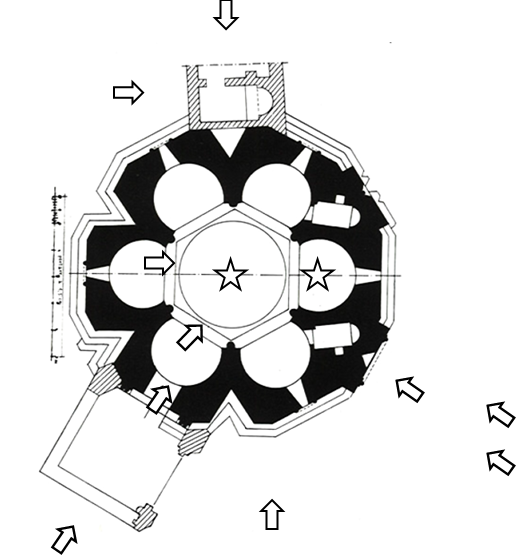Nazenie Garibian
This small, well-preserved church in Ani was one of the earliest monuments constructed after the city became the capital of the Armenian Bagratid kingdom in 961 AD. It is situated in the central quarter of the city, within the first walls of King Ashot III (964), on the west side of the plateau looking out onto the Tsaghkotz Valley. The church was supposedly founded in around 980 by prince Grigor Pahlavuni (d. 982) or by his wife Shushanik, as suggested by two inscriptions that mention their names. A long inscription of 1040 left by Ablgharib, their younger son (who also founded the church of St. Saviour in Ani), implies that he re-consecrated the church as the funeral chapel of his family and that he constructed burial chambers for his father, brother and sister. During the excavations of 1907, the ruins of two chapels (dedicated to St Stephen and St Christopher) were discovered against the northern side of the church. Between them, was once situated the sepulchre of Grigor Pahlavuni.
This elegant mausoleum of the Pahlavuni dynasty presents one of the early examples of the new style that developed during the architectural renaissance in Ani during the late 10th and early 11th centuries. This style is characterised by the vertical evolution of the building composition and by the mixing of tradition and innovation. The church is a domed semi-free polygonal rotunda with two levels. The ground level comprises six deep horse-shoe-shaped conches enclosed in the dodecagonal perimeter: the sides constitute alternating window and dihedral niches. The cylindrical drum is squat and the semi-spherical dome is capped with a low cone made of slabs of tufa. The single door is orientated not to the west but to the south west of the church, probably due to the topographical peculiarity of the spot. It gives access to the interior space, which is well illuminated thanks to the six windows in the conches and the eight windows of the drum. The base of the drum rests on the six arches supported by the engaged columns that separate the conches. The apse of the sanctuary is flanked by two tiny chapels – built at a later date – that are accessed from the neighbouring conches.
As is often the case in the funeral chapels of noble families in Armenia, particular attention is given to the sculptural decoration which shows a harmonious coexistence of tradition and innovation.
On the outside, the lower parts of the walls are almost naked; on the upper parts a moulding goes around the perimeter of the monument, encircling the arches of the niches and windows at a certain distance. The arched windows are mostly enclosed by two frame-linings, either of double engaged pillars or of the twisted-torus type. The moulding that goes around niches and windows, in this way, is borrowed from apses of the 7th century. But the columns that frame the windows combined with arched cornices are an innovation.
The eastern façade is somewhat different: the window is smaller and surrounded by a foliage string-course beneath a rosette arch, capped by a cartouche containing one of the inscriptions mentioned earlier. On either side, the niches are topped by a thick lintel, which is moulded with bevels and dentils.
The drum is segmented by an original double arcade composed of two tori, the lower one of which is twisted. There are no impost-capitals between the arches and the pillars: they form a continuing decorative strip. Inside the arcades, the windows are encircled by two twisted tori. All this decoration is new and characterises the architectural style in Armenia in the second half of the 10th century.
Inside the building the conch arches rest on semi-pillars engaged by means of impost-capitals of the late Armenian composite type: they are flattened with a fluted vase and a thick abacus decorated here with symmetrical palmettes and multiple balusters. On the conch walls, traces of frescoes, probably from the 13th century, are still visible.
The typology of the funeral chapel going back to the early Christian martyria had some success in the 11th and 12th centuries, notably in the provinces of Tayk and Shirak.
Interactive Plan



